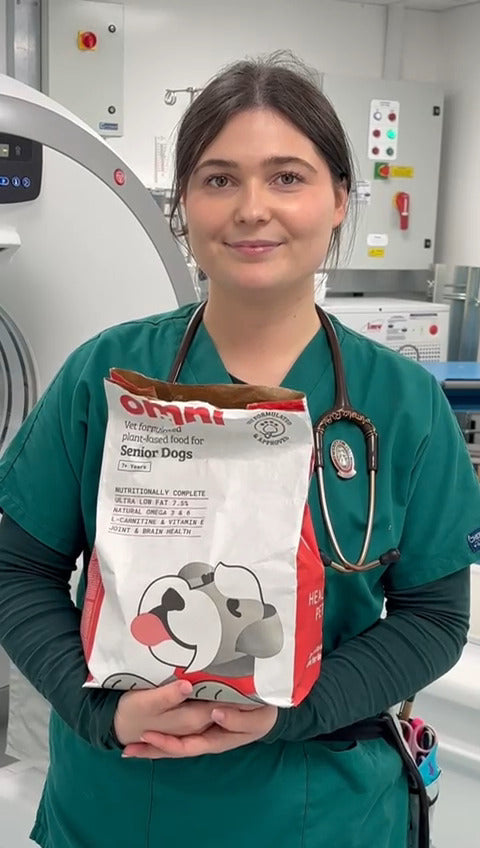8 Top Tips to Help Your Dog Through Firework Season | Ask a Vet | Omni.pet

Firework season is a stressful time for dogs - as with many animals, they simply don’t understand what on Earth the loud bangs in the sky are all about!
Cats have been known to startle and get run over; birds fly the nest, get lost, and never find their way back; and dogs, of course, often whimper and cower in the corner of the room with their tails between their legs.
The sudden loud noises, bright lights, and unpredictability can trigger fear and anxiety in many pets, leading to restless behaviour, excessive barking, and sometimes destroying anything you’ve left lying around - even items of furniture! - as a coping mechanism.
Fortunately, there are several steps you can take to help keep your dog calm during this time, from preparing your environment to using specialised supplements like Omni's Stress & Anxiety Supplement, with active ingredients proven scientifically to reduce stress levels during firework season.
Here’s a guide from Omni’s Vet Team to help you and your dog get through firework season as smoothly as possible:
1. Talk to Your Neighbours About Silent Fireworks
One of the most proactive steps you can take is to encourage your neighbours to use silent fireworks or quieter alternatives. Silent fireworks offer the same visual spectacle but significantly reduce the noise, making them much less stressful for dogs and other pets - and, let’s face it, people go to fireworks for the display, not for the noise!
Silent fireworks have become increasingly popular in many communities, especially where there are noise-sensitive animals or young children. Start a conversation well in advance of firework season with your neighbours to raise awareness about the benefits of silent fireworks for dogs and other animals, and ask them kindly to consider the option.
2. Create a Safe Space for Your Dog
Dogs often feel most secure in a familiar and quiet environment. Ahead of firework season, create a safe space in your home where your dog can retreat when they feel anxious. This could be a quiet room with their bed, toys, and perhaps a covered crate to give them a sense of protection. Ensure the area is cosy and full of reassuring, familiar scents and textures.
You can also dampen the noise by closing windows, drawing curtains, and turning on the TV or radio at a moderate volume to mask the sound of fireworks. Calming music or white noise can also help create a more soothing atmosphere for your dog.
3. Try the Stress & Anxiety Supplement For a Month (At Least!)
For an extra layer of support, consider using Omni’s Stress and Anxiety Supplement. This supplement is designed specifically to help dogs cope with stressful situations, including fireworks. Packed with natural ingredients like L-Theanine and Valerian root, it can help reduce anxiety levels and promote a sense of calm.
Supplements like this can be used as part of a holistic approach to managing your dog’s stress, particularly if they struggle with severe anxiety.
For best effects, use the Stress & Anxiety soft chews for 1-2 months before firework season begins to ensure maximum effect. Studies have shown that supplementation with natural compounds like L-Tryptophan, Passionflower and Valerian Root is an effective way to reduce cortisol levels in your dog during firework season.
- Start Desensitisation Training
If your dog experiences intense fear during fireworks, desensitisation training can be incredibly effective, especially if you start it well before firework season. Desensitization involves gradually introducing your dog to the sound of fireworks at a low volume, helping them build tolerance over time.
Here’s how to do it:
- Find recordings of fireworks and play them softly in the background while engaging your dog in positive activities, like playtime or mealtime.
- Slowly increase the volume over the course of several weeks as your dog becomes more comfortable.
- Pair the sounds with positive reinforcement, such as treats or praise, to help your dog associate the sound with good things.
This method works best when started early but can still be beneficial if you’ve only got a few weeks before the big night.
TOP TIP: The Stress & Anxiety soft chews and Peaceful Dogs Treats make for great rewards when providing your dog with positive reinforcement!
5. Divert Your Dog
During fireworks, one of the best ways to manage anxiety is by distracting your dog with activities they enjoy. Try interactive toys, such as food puzzles or chew toys, which can keep their focus away from the noise. Playing a game of fetch indoors or offering a long-lasting treat like a stuffed Kong can also be effective ways to keep their attention occupied.
Exercise is another great tool—make sure your dog gets plenty of physical and mental stimulation during the day. A long walk or play session before fireworks start can tire them out, making them more relaxed in the evening.
6. Plan Walks Wisely
To avoid your dog being outside during the loudest part of the night, plan your walks and bathroom breaks well in advance of any firework activity. Try to give your dog their evening walk before dusk or the time you expect fireworks to begin.
This minimises the risk of them being startled by sudden loud noises, which could lead to bolting or excessive fear. If fireworks start unexpectedly while you’re outside, it’s crucial to keep your dog on a leash to prevent them from running off.
7. Act Natural!
It comes as no surprise that most dogs are incredibly sensitive to their owners' emotions; if you’re visibly anxious, they are more likely to feel stressed too. One of the simplest though most effective strategies during firework season is to remain calm and act as normally as possible. Avoid over-reassuring your dog, as this can sometimes reinforce their fearful behaviour. Carrying on as normal can help them to follow your lead.
Instead, provide comfort by sitting close by, but focus on maintaining a relaxed demeanour and keeping the routine as normal as possible. This can help signal to your dog that there is no real threat and that, if you feel safe, then they can too.
8. Consult Your Vet for Severe Anxiety
If your dog experiences severe anxiety during fireworks and none of the methods above seem to help, it might be time to consult with a veterinarian. In some cases, prescription anti-anxiety medication can provide relief during particularly stressful events. Your vet can assess whether this is a suitable option and help develop a more targeted plan for managing your dog’s fireworks-related anxiety.
Conclusion
Firework season doesn’t have to be a traumatic time for your dog. By preparing in advance, creating a calm environment, and using tools like Omni’s Stress & Anxiety Supplement, you can help reduce the impact of fireworks on your pet’s well-being.
Combining desensitisation techniques, safe spaces, and natural calming aids will not only help your dog stay calm but also ensure that you both can enjoy a peaceful night together.
With the right strategies and a little patience, you can help your dog navigate firework season stress-free!







 85 Great Portland Street, 1st Floor, London, W1W 7LT United Kingdom
85 Great Portland Street, 1st Floor, London, W1W 7LT United Kingdom